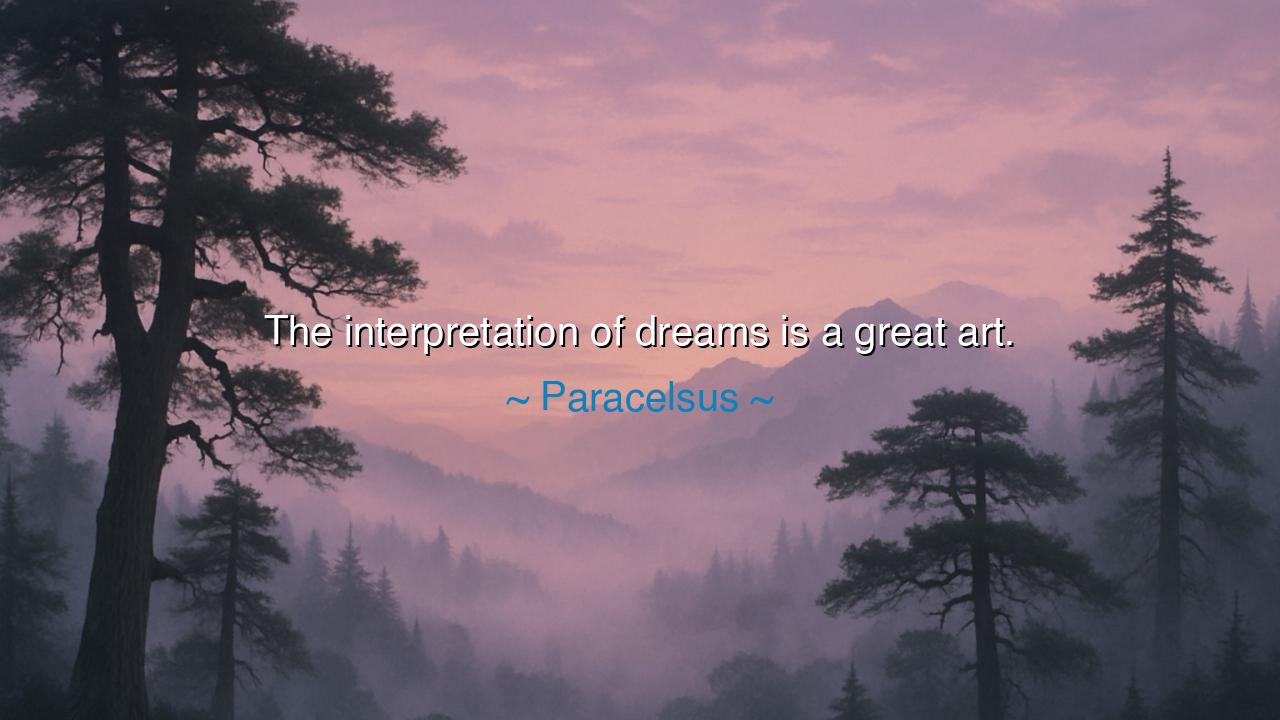
The interpretation of dreams is a great art.






“The interpretation of dreams is a great art.” — Thus spoke Paracelsus, the wandering physician and mystic of the Renaissance, whose heart was as steeped in alchemy as his mind was in science. In these few words, he captured the mystery that bridges the waking and the unseen worlds — the belief that dreams are not random shadows of thought, but messages from the deeper self, from the divine, or from the secret architecture of the soul. To interpret dreams, he said, is an art, not a science — for it requires not mere intellect, but intuition, reverence, and the inner eye of wisdom.
In the ancient days, before logic ruled the heart, the dream was regarded as a holy revelation. The Greeks built temples where the sick would sleep to receive healing visions from the god Asclepius. The kings of Egypt and Babylon consulted dream interpreters before wars and coronations. Even the prophets of old spoke of dreams as the language through which the Infinite whispered its will to humankind. And Paracelsus, inheritor of this ancient lineage, reminded his own age — which was turning cold with reason — that there is truth in the symbolic, that to listen to a dream is to listen to the voice of the soul itself.
When he said that it is a great art, Paracelsus meant that dream interpretation cannot be reduced to formulas or rules. Like painting or music, it requires sensitivity, imagination, and harmony with unseen rhythms. A symbol that means joy to one person may signify sorrow to another; a dream is born from the secret life of the dreamer, and to interpret it rightly is to know both the symbol and the soul behind it. The art lies not in guessing, but in seeing — in discerning the pattern hidden within the mist, in feeling the pulse of meaning beneath the veil of vision.
Consider the story of Sigmund Freud, centuries after Paracelsus. Freud, though a man of science, walked the same ancient path of dream inquiry. He listened to his patients’ dreams and found within them not nonsense, but truth disguised in symbol. The fears they buried, the desires they denied — all revealed themselves in the theater of the night. Freud gave the world a modern key to the ancient temple, proving once again that dreams are not madness, but mirrors of the soul. Though his methods were new, his vision was old — the same fire that burned in the heart of Paracelsus.
But where Freud sought knowledge through analysis, Paracelsus sought wisdom through reverence. For him, dreams were not only reflections of the human psyche, but bridges between worlds — between body and spirit, earth and heaven. To interpret them was to perform a sacred act, a communion with the unseen. The dream was a letter from the divine written in the language of symbol, and the interpreter was its translator. Thus, to misunderstand a dream was to misread a message from one’s higher self — a mistake that could cloud both mind and fate.
The art of dream interpretation, then, requires stillness, humility, and a heart attuned to mystery. One must listen not with the mind alone, but with the soul. Paracelsus would say: do not mock your dreams, nor cast them aside as foolish fantasies. They come from the same deep well from which your life itself flows. Within them lie warnings, healings, and revelations — if only you learn to read their symbols with care.
The lesson is this: pay attention to your dreams, for they are the night’s conversation between your mortal self and your eternal one. Record them upon waking, ponder their symbols, and ask what truth they might conceal. In the restless images of sleep, the soul speaks honestly, freed from fear and pretense. To interpret those words is not to control them, but to learn from them — to let them guide you toward self-knowledge, healing, and peace.
So remember the teaching of Paracelsus, wise physician of both body and spirit: “The interpretation of dreams is a great art.” Approach your dreams as you would a sacred painting or a divine riddle — with patience, wonder, and love. For in the shifting light of those nocturnal visions lies not illusion, but the living language of your own soul, calling you back to the truth of who you are.






AAdministratorAdministrator
Welcome, honored guests. Please leave a comment, we will respond soon